The changing of the seasons from summer to autumn is a favourite time of year for many. The turning leaves and the activity of wildlife can be a feast for the eyes if we get the opportunity to go outside. It may also signal the onset of SAD for many, from the darker mornings and evenings and less time to appreciate the daylight.
One way to improve mood and cultivate mindfulness, which can help through the darker months, is to practice mindful walking. Taking the time to tune into our bodies and our environment can bring a new appreciation for the colder months and can lift the mood enormously.
Mindful walking doesn’t mean taking a hike through the countryside however. It can be practised anywhere; in nature, during the commute or even indoors.
So what is it?
Mindful walking can take many forms but largely falls into one of two categories (or a mixture of both): body awareness and environment awareness. To practice body awareness, we can move with the breath, observing the natural breathing pattern or tuning the breath into each step taken. With environmental awareness, we move steadily but turn our attention to our sensory experience of the environment. What we can see, hear, smell, feel etc. The important thing to remember, mindful walking is not about travelling from A to B, it’s not about getting somewhere. It’s about fully experiencing the present moment through the action of walking.
How to do it
Body Awareness
- Start walking at a slow and steady pace. Try to match your steps to your breathing but keep the breathing pattern natural rather than extending the breaths.
- You can hold your hands and arms where they are comfortable – at your sides, behind your back, wherever you like
- Get used to this pace as you walk around your garden, around your house or along the street – wherever you choose
- Start to bring your awareness to the feeling of your feet touching the ground. The contact points at various moments of each step. Notice how your arms move. Notice the sway of your hips and your balance as your step from one foot to another. Notice how you hold your head and shift your gaze as you walk.
- If you get distracted, gently bring your attention back to the awareness of your body in motion
- Try mindful walking for 10 minutes and as you finish, pause for a few moments and set an intention to take mindfulness into the other activities of your day.

Environment Awareness
- Start off following the first three steps as for body awareness above
- When you are walking with the breath at a comfortable pace, start to shift your awareness to what you can see. Raise your eye level to take in your surroundings fully. Notice the shapes, colours and textures of the things in your environment. Really take in the details.
- Next move to what you can hear; the breeze, trees rustling, birdsong, vehicles, people talking, machinery – whatever it is, really pay attention to the sounds in the moment
- Move on to what you can smell and feel. Use your senses fully to anchor yourself in the present moment.
- If you get distracted or carried away by thought, just bring yourself back to the sensations of the moment as you steadily continue to walk.
- As you finish, set yourself a mindful intention for the day.
As you become more experienced at mindful walking, you can try increasing the pace (if you want to) so that you can move mindfully wherever you are going. Otherwise, you can keep mindful walking as a formal practice that you make time for each day.
Mindfulness in sports
Mindfulness is the practice of applying awareness to the present moment through sense-based experience rather than thought. In other words, the ability to bring attention to what is happening right now, without imposing judgments on the quality or meaning of the experience. In practicing mindfulness, sportspeople are able to notice thoughts as passing mental events that don’t require action. The ability to observe in this way can lessen the reflex response to a situation and increase the ability to respond in a calmer more objective way.
We often remember the sporting outbursts (John McEnroe, Zinedine Zidane to name but a few) where players are overcome with rage, feelings of injustice or unfair treatment, or respond negatively to crowd interference. With athletes not only needing to consistently turn in their best performance, but also being role models for fans and aspiring young people, changing the way individuals react to thoughts is a growing area of focus in sports.
A Chosen Response
It is not just the one-off outbursts that sportspeople have to contend with; performance anxiety is a large factor whether you are a team player or individual athlete. So how can mindfulness help? Mindfulness can help individuals become aware of their thoughts, bodily sensations and environment. Through noticing as an observer what is happening in the present moment, we can choose to respond in a certain way instead of relying on the reflex, learned response that often isn’t the most helpful.

We can choose to notice the environmental conditions and make adjustments to our play. We can notice how certain scenarios cause tension in the body and we can choose to relax those parts of the body. Or, we can just notice as an observer and watch the feelings or thoughts arise and pass away – they are mental events that don’t necessarily need a reaction; especially where the thoughts are unhelpful or negative or likely to elicit a negative response. Sport can be a very stressful environment. Mindfulness can help individuals to let go of emotional responses and instead help them to act with more balance and wisdom; this could be the difference between winning and losing.
Improving Focus
Often in competitive sports (professional and amateur) it’s easy to ruminate on past mistakes or predict an outcome before the performance has even started. Mindfulness brings us back to the present moment – what is happening right now? By focusing only on what is happening in the moment, thoughts of predicted failure or learned reactions to past events start to lose their power. Our minds and bodies find a freedom to perform in the moment.
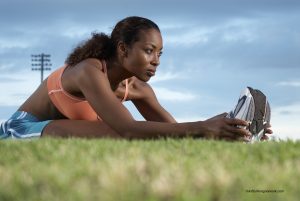
As an amateur competitive cyclist, I have felt and witnessed performance anxiety and the effects it can have on the enjoyment and outcome for individuals. It’s easy to slip into the mental cycle of berating yourself for not doing well, or having moments of self-doubt. Mindfulness might not stop these moments, but it will teach you how to observe them purely as mental events and not based on the reality of the moment. Bringing yourself back to the present and anchoring attention on your breath is a powerful practice to overcome attachment to negative thought patterns. Trying a simple breathing practice before an event can reset the mind and body to be able to focus productively on the current situation.
Positive Imagery
Mindfulness is a powerful method for creating space in the mind which can then be used to meditate on positive visualisations. Utilising the senses can affirm visualisations bringing them to life with vividness that can overcome anxiety and negative thought patterns. Creating a positive mental image of a shot, play, race or outcome can help increase confidence and focus making mindfulness an essential practice not only for success, but also for enjoyment.

Practicing mindfulness is mental training that helps refocus awareness so that attention can be redirected purposefully to help you perform to the best of your ability. As with all training, it is a process that requires commitment and repetition. Mindfulness begins with a sitting practice and deliberate times set aside for mindful enquiry. This then moves on to mindful movement and can become a whole of life practice that can be utilised on the court/pitch/field/track before, during and after performances.
The Well Nest could help your sports team to improve performance through the practice of Mindfulness. To learn more about mindfulness, tailor a mindfulness package for your club or team or to register for mindfulness courses in Staffordshire (suitable for everyone, not only athletes) take a look at the Mindfulness pages or contact [email protected]
Letting go of the past
Letting go of the past will be an issue for most people at some point in their lives. We can all remember hurtful things that were said to us decades ago, or bad experiences that we (knowingly or unconsciously) allow to affect our future experiences. I think we would all agree that being able to let go of the past would provide us with more space in our minds and more peace in our lives.
So how do we do it? It comes back to basic mindfulness principles of being in the present moment, using an anchor to keep us there and staying intentionally and without judgment.
Something that should help us gain some perspective on letting go is that the past has already been and gone; it has been let go of already. What our mind is holding onto is attachment to an event, thought, experience or occurrence from the past. It’s that attachment that stays with us and effects our mind over and over again. When we go into the ruminative state, we run the past (or an imagined future) over and over in our minds. Neither the past nor the future exist; it’s just our thoughts that disturb the mind.
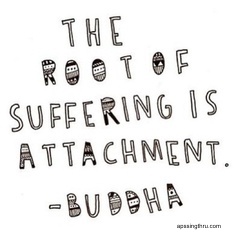
If we repeatedly bring ourselves back to the present moment, our mind will start to learn not to dwell in the past and slowly we will let go of attachment or harmful/negative thought patterns that seem to have power over us. One of the best anchors that we can use in our practice of letting go is the breath. It’s always with us and accessible at any time. Bringing awareness to the breath frees the mind from the past and brings it immediately into the present moment. A simple breathing meditation can be used any time, any place and can provide immediate relief from unhelpful thoughts based on the past. By being in the present moment, we are forced to let go immediately of our attachment to the past. The process won’t be easy and it will take time to be free from attachment to the past for longer than a few moments, but practising bringing ourselves back to the present moment will train the mind to let go.
If the breath doesn’t work for you, or your thoughts prove a stronger anchor than observing the breath, you can try a sense based mindfulness practice; using what you hear, see, smell, feel etc in the environment at that moment to keep you in the present.
Using mindfulness to break down attachment stems from Buddhist teachings and practices that have worked for providing mental calm and clarity for many hundreds of years. The Buddhist tradition that I follow very much focuses on making Buddhist teachings practical and accessible for the modern world. Applying traditional mindfulness techniques in practical ways means the application of this ancient knowledge is relevant to helping us solve our modern problems.
Try something old; to find something new.
Winning Ways to Wellbeing
I visited a primary school in Warwickshire recently and was pleased to see a display promoting wellbeing through 5 practical steps that are now promoted as basic steps to wellbeing all over the world. The ‘5 ways to wellbeing’ outline simple steps that we can all take to improve our wellbeing and are now advocated by the NHS in order to help people actively take control of their wellbeing. Starting small and building to a holistic approach to wellbeing can help us lessen or avoid more long-term conditions such as depression or anxiety that can effect physical and mental health for many years.
But what is wellbeing exactly? What are we trying to improve? Undoubtedly our mental health and states of mind, but wellbeing is a whole of life experience. An improvement in our overall quality of life and experience through practical, active steps to increase our levels of enjoyment, self-worth, physical and mental health and interactions with others.
This sounds like a big challenge, right? Definitely. But luckily the 5 ways to wellbeing really do work and are a great start to improving wellbeing.
The 5 Ways to Wellbeing
- Connect – There is strong evidence that being around others (friends, family, social groups) not only increases our all-round wellbeing, but also increases our longevity. Talking is the best therapy. You don’t have to share everything with others; start small. Make a meaningful connection instead of living in the digital world all the time. When you ask someone how they are, actually listen and pay attention to the answer. Speak to a stranger or make conversation while waiting in a queue. Try car sharing with a colleague; they might even become a friend.
- Be active – We have all read the decades of evidence that shows being physically active improves our mental health…so why do we still doubt it? Because it’s not easy to get active and stay active. But it’s not hard either. There are small changes we can make on the way to becoming more active and improving wellbeing. Take the stairs instead of the lift. Take a class after work with colleagues or organise a new sporting activity for all work colleagues to try. Go for a walk at lunchtime. Get off the bus a stop earlier and walk to your destination. If you feel like more of a challenge, take up a regular class that is proven to aid concentration, inner peace and help sleep…yoga is the obvious.
- Take notice – The basics of mindfulness; notice your surroundings. Be present in the moment and just ‘be’ instead of always ‘doing’. The only moment that exists is right now, so try to pay more attention to what is really going on instead of living in your head thinking about what has already happened or what might happen. Being mindful increases our awareness and knowledge of the self. If we know what we spend our time thinking about, we can start to change our thought patterns for the better. Living mindfully is a difficult task for the novice, but we can all try small steps. Choose a mindfulness cue; a sound or sight that whenever you hear/see it reminds you to take 60 seconds to be mindful and notice what’s going on in the environment.
- Keep learning – Not only is the mind kept active, but there is the chance for social interaction, being mindful and being active all rolled into one here. Continued learning can enhance self-esteem, motivation and can help you to prioritise goals and your own happiness. This doesn’t have to be a formal class to count as learning. You can try learning a new word each day, try reading the news in a foreign language, listen to classical music, join a book club.
- Give – By giving to others we develop our compassion which in turn increases our compassion for ourselves. Engaging in acts of kindness helps us to gain perspective on our own internal struggles and gain an understanding of the greater good. Giving your time, expertise or just random acts of kindness to others can greatly increase your wellbeing and decrease your attachment to seeking happiness through material gain.
A challenge…
I challenge you to try the 5 Winning Ways to Wellbeing for one week and track how you feel in body and mind. Leave a comment below about your experiences and check back to see my review of a week of Winning Ways to Wellbeing.
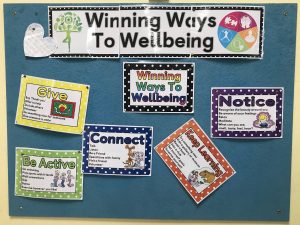
A Mindful Holiday
 We all love to ‘get away from it all’, ‘leave our troubles behind’ and enjoy a holiday (maybe several if we’re lucky) each year. We have a plan of where to go, what to see, what to do and even the places to eat, the number of hours we want to spend on a beach, the sights we want to tick off our ‘to do’ list. For how much of our holidays are we actually present? Really present…paying full attention to what we’re doing in the moment, not thinking about the next thing we’re going to do or how what we did this morning perhaps wasn’t as great as we thought it would be.
We all love to ‘get away from it all’, ‘leave our troubles behind’ and enjoy a holiday (maybe several if we’re lucky) each year. We have a plan of where to go, what to see, what to do and even the places to eat, the number of hours we want to spend on a beach, the sights we want to tick off our ‘to do’ list. For how much of our holidays are we actually present? Really present…paying full attention to what we’re doing in the moment, not thinking about the next thing we’re going to do or how what we did this morning perhaps wasn’t as great as we thought it would be.
We all hope that a trip away will be the ideal escape from work, from stress, from real life. As soon as we recognise that physically moving out of the sphere of our troubles or busyness doesn’t actually rid us of those things, then we can get the most out of our breaks and life generally.
Happiness and peace of mind can occur anywhere at any time, as long as we are in the present moment, paying attention, on purpose.
Paying attention
We can get the most out of our holidays by simply paying full attention to what we’re doing. I enjoy driving in continental Europe, and I think it’s because I pay so much more attention to the task of driving than I normally do. I’m constantly watching, listening, feeling the roads. My focus is fully on the task…and it becomes enjoyable. My mind is not on the destination and what I’m going to do when I get there…it’s just on the very moment of driving.
Pleasure and peacefulness can be found in many places that might usually frustrate us when we’re on holiday. Being stuck in traffic might seem like a waste of time leading to frustration or irritation, but it’s also a great opportunity to people watch, to observe the real life of another country or culture, to take in the sights and sounds of the places we pass through.
How to holiday mindfully
So, you’ve paid a lot of your hard earned money for a break – how do you get the most out of it by using mindfulness? There are a number of top tips for this…
- Walk as often as possible. This could be to get from A to B or to explore an area or just to get to the shops or beach. Leave the car behind. Being on foot gives you endless opportunity to practice mindfulness. Feel the ground under your feet, listen to everything you can hear in the moment; the language, the breeze, music, traffic, life going on right now. Focus on taking in life as it happens in the moment. When you are outdoors under your own steam, there is so much going on to focus your attention on now. If you aren’t able to walk, spend some time sitting outside and let your senses fully take in the environment.
- Use your senses. Don’t just look at things, take a picture and move on. We are very visual by nature and that’s fine, but we have 4 other senses to work with. Listen to what’s going on, what does the city/forest/beach/mountain where you are sound like? Think back to your last holiday – if someone asked you to describe what your destination sounded like, would you be able to do it? Similarly with smells, we only notice the extremes of good or bad. Try to focus in on the smells of the sea air, the leaves and vegetation, the traffic, any animals nearby, food cooking etc. All these things bring you into the present moment so you create stronger memories and find more peace, more genuine ‘escape’ from busyness. The same approach works with taste and touch; use all your senses to bring yourself into the present.
- Use photography differently. In the age of social media, we carefully construct or contrive images to draw the most appreciation from strangers. Try taking photographs of real moments, real life. Take photos that draw your attention to what your senses (other than sight) are experiencing. Create memories of touch sensation, smell, sound etc. In the present moment, it will draw you right into focussing on now, but later, your images will also serve as mindfulness cues that you can rely on in everyday life.
Remember, the core of mindfulness is to be present, whether that’s on holiday or at home. We often feel obliged to pack in as much as possible when we’re on holiday as it only happens a few times a year. Try to move from ‘doing’ to ‘being’. Don’t just pass through life, really live it.
Mountain Meditation
Mountains are often admired from afar for the qualities that they appear to have. Some of these qualities we find beneficial and seek in life: stability, longevity, calm, unwavering and balanced. When we spend some time really contemplating the image of a mountain, we see that it is constant and reliable through the seasons; it is a home for plants and animals; it provides shelter and protection; it abides in tranquility through the centuries.
While it’s often the case that we try not to actively ‘think’ in passive meditation, we can use the visualisation of a mountain in active meditation to assist us in contemplating and finding inner peace. If we spend time on the visualisation we can imagine ourselves taking on the qualities of the mountain.
The Mountain Meditation can be used as a regular practice or as an escape from the rigours of daily life as and when required. I use the Mountain Meditation often as a precursor to sitting with mindfulness of breathing; it acts as a relaxation technique and brings focus before working on expanding awareness.

How to do it…
- Sitting in a comfortable position on a cushion or chair, have the back straight but not tense and the hands resting in the lap.
- Bring the gaze down towards the floor and gently close the eyes.
- Spend a few minutes on breathing meditation/mindfulness of breathing
- Picture in your imagination a mountain – it could be a snowy mountain of the Alps or Himalayas, it could be a forested mountain bathed in sunshine
- Try to bring your image of a mountain into clear focus
- Observe its shape, lofty peak, solid based, gentle or sharply sloping sides, its surface (rocky, smooth, dusty, forested, snowy etc)
- Notice it’s enormous size and how solid and unmoving it is from afar and up close
- Try to bring the qualities of the mountain into your own body – your head becomes the lofty peak, sitting in your chair you are rooted at the base. Your arms become the slopes of the mountain. Feel the sense of uplift from the base of your body projecting through the crown of your head.
- The mountain experiences the force of the seasons – sun, rain, snow, gales. Through it all, it sits unchanging, experiencing all that comes its way
- The mountain never resists, complains or judges – it accepts everything, just being itself
- We can imagine embodying the same unwavering stillness and calmness.
- We can experience the fullness of life and its changes through the seconds, hours, years
- We will experience the changing nature of our minds, our body, the outside world. We will have periods of shade and of light. We can maintain the peace of the mountain throughout.
- Sit in stillness for a while.
- Gently open your eyes and mindfully arise from meditation after around 20 minutes.
The Benefits of Yoga
We’ve all heard that yoga is good for body and mind but isn’t it all just a bit of gentle bending and stretching? What’s all the fuss about…?
The combination of breathing, relaxation, meditation, strength, balance and dynamic movement often found in yoga classes can bring a complete overhaul to our often chaotic lives and busy minds.
Some of the benefits of yoga are more obvious; it builds muscle strength, improves flexibility and stamina, it improves posture, strengthens bones and protects cartilage, it increases heart rate and blood flow and helps drain the lymphatic system. These benefits come from the physical practice, Asana.
It can also help focus and concentration by being mindful of the body and the present moment. The deep and complete relaxation that can come from a yoga practice can fully relax the nervous system. We often spend most of our time in ‘fight or flight’ mode where the sympathetic nervous system is stimulated. This can trigger long-term stress responses and ill health. Yoga is calming and restorative and stimulates the parasympathetic nervous system, lowering breathing and heart rate and bringing the body back to balance.
Yoga is also very useful in providing relief from chronic conditions. A regular practice utilising the full range of body movement improves mobility, flexibility and self esteem. It also improves mood and motivation; you will be more inclined to be active as progress physically, brings progress mentally.
Join a class with The WellNest to see how yoga can improve your body and mind.
Yoga Masterclass with Yogi Ashokananda
One of the great joys of yoga is that no two teachers are the same. It’s so exciting to experience new flows, styles of teaching and types of yoga to keep the love of yoga alive.
This was the first time I’d managed to book my first choice workshop at the Om Yoga Show (show review can be found here). The session was 90 minutes long for the bargain price of £10. I expected the room to be an uncomfortable, overcrowded affair, but I was pleasantly surprised. Mats were well-spaced and there was enough room to spread out without getting too close to your neighbour (it’s just not very British to touch a stranger – especially a sweaty one).
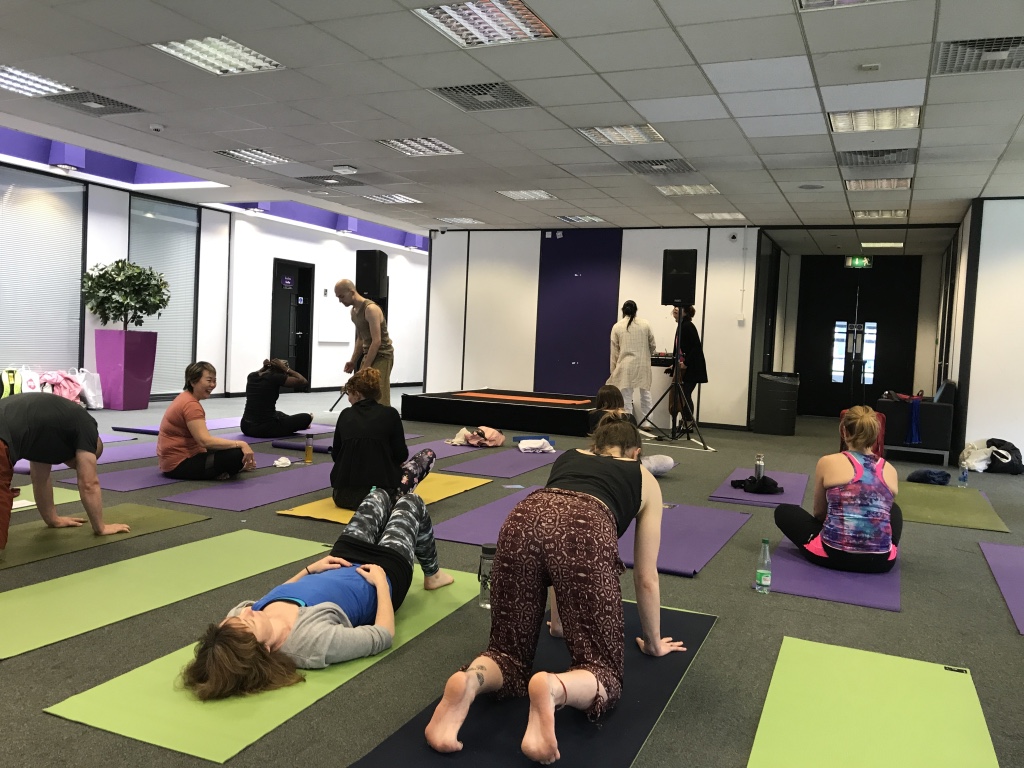
The workshop was billed as a Himalayan Hatha Yoga series with energy to create freedom and lightness in the body. There were intense sun salutations with upward dog kept on the toes rather than the tops of the feet. Looking around, I could tell that everyone found this a change from their ‘norm’. There were people of all abilities in the class which is always great to see and be part of.
We were put through our paces using fast flows, arm balances, strength postures and some of the most intensive Kriya and pranayama I have ever experienced. The breath holds and transitions worked to cleanse the body, generate heat and still the mind. It was very tough! We worked through standing postures testing balance and strength. We added in fast arm movements to challenge concentration and work alongside pranayama. There were opportunities to try transitions from headstand to side crow and back and chair to flying pigeon to name a few. There were also challenging bound postures which I enjoy but really test the limits of patience and surrender. This was a full body and mind workout. We sweated…a lot.
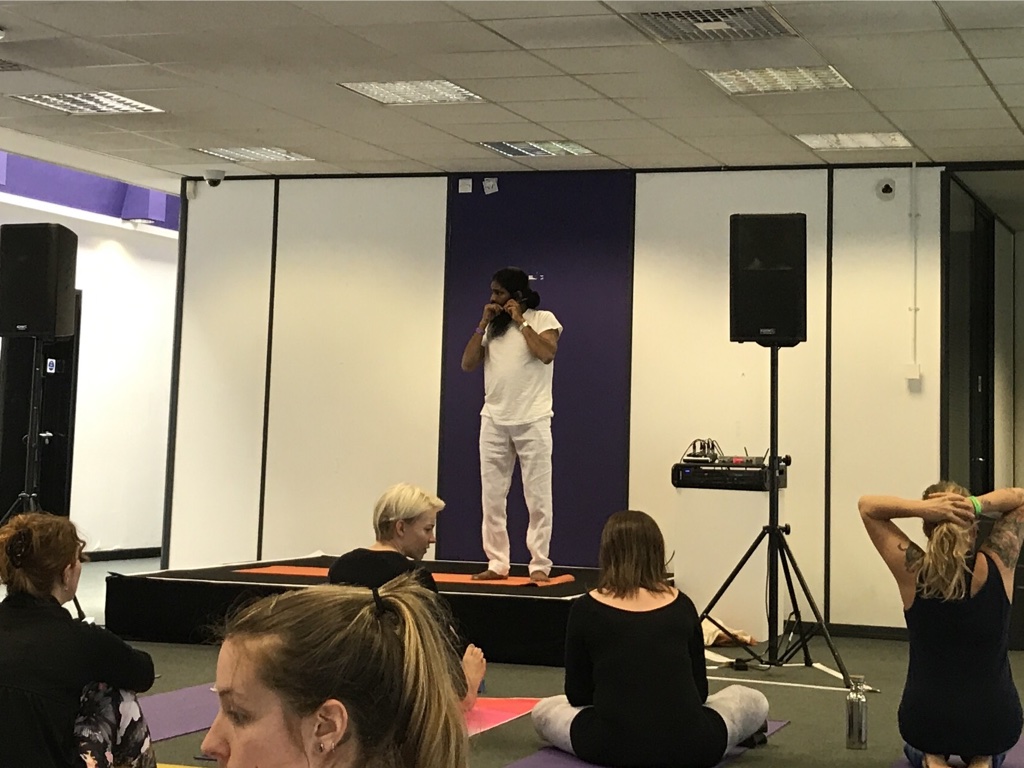
Yogi Ashokananda was encouraging and warm. Although he moved through transitions quickly he was clear in his instruction – although firm when he spotted we were flagging. He added in asanas and movements I haven’t tried or heard of before (wagtail or cheetah pose anyone?) but they were intense. I really enjoy this physical form of yoga because pushing the limits of the body helps to control the mind. I really found this a transformational session and have since used some of Yogi Ashokananda’s practices in my classes, particularly how to move within postures rather than just the traditional holds. I also really enjoyed using pranayama and kriyas as an integrated practice while doing asanas rather than sitting down and doing them separately.
The only let down for me was the poor quality of yoga mats that were provided. They were slippy to the point of being dangerous in a class such as this where sweat was an inevitability. Holding downward dog was a feat of concentration and resolve. I recommend taking your own mat to the Om Yoga Show if you intend to do a workshop.
We finished with some chanting aloud (again not very British) which everyone engaged with (surprisingly). I’m not familiar with the verse we chanted but many were so it was great to be a part of it. I always enjoy some Om chanting at the end of a class though, it just really fills me with happiness.
Yogi Ashokananda prepared us well for the class by saying “corpse pose is called corpse pose for a reason. You shouldn’t do it unless you feel like you’re going to die. Five straight hours of yoga will make you feel like you’re going to die…you only get to do savasana then”. He stuck to his word…there was no savasana after the most intense 90 minutes of yoga I’ve ever done. But, he was right. I didn’t need it and I didn’t miss it.
Namaste
OM Yoga Show 2017 – Manchester show review 19-21 May
This was my sixth visit to the Om Yoga show and the second time I’d been to it in Manchester. At £7.50 entrance fee this is a true bargain. After a succession of London venues that seem to be impossibly difficult (and time consuming) to get to, I thought the chance to drive ‘up north’ would be welcome.
The new venue at Event City was an excellent choice! Loads of free parking right outside the door. It was easy to get to and refreshingly didn’t involve multiple bus/train journeys and lots of waiting around – something that can’t be avoided in getting to the London venues of Alexandra Palace and Olympia.

Goody bags were freely available – no scrum necessary – just inside the door. We were able to help ourselves to show guides and freebies (powdered, vegan supplements for smoothies). The venue was large with lots going on this year. I always feel like the Manchester show might be the poor relation of the London event, but not true this year.
The bonus is that as it’s not as busy as the London show, you can actually get the chance to get into the open classes without a 30 minute queue and this year was the first time I’d managed to book onto my first choice workshop.
The best thing about the Om Yoga show is that it’s a hive of thriving young British businesses – loads of innovation and creativity in clothing, food, drink, styles of yoga and equipment that are freely available to us British yogis.
There was a strong display of exhibitors from therapists, food producers, tea importers, meditation aids, equipment, books, clothing, accessories and interiors. Really everything you’d want to see at this kind of show and far more. The Manchester show is definitely not a runner-up to London any more.
There were 3 open class studios, a children’s yoga studio and a meditation area this year. Classes ranging from gentle introductions, innovative new styles, traditional asanas, challenging backbends and arm balances and focus on all 8 limbs of yoga with some Ayurveda and holistic therapy thrown in. There were 93 free classes to choose from this year so it’s not just a day of shopping and browsing – there are multiple good quality activities to fill the day as well. With about 15 workshops per day ranging from £5 to £10 there were also some world class teachers to choose from for a more in-depth experience. I booked onto a masterclass with Yogi Ashokananda for £10 – the best yoga class I have ever been to! My workshop review can be found here.
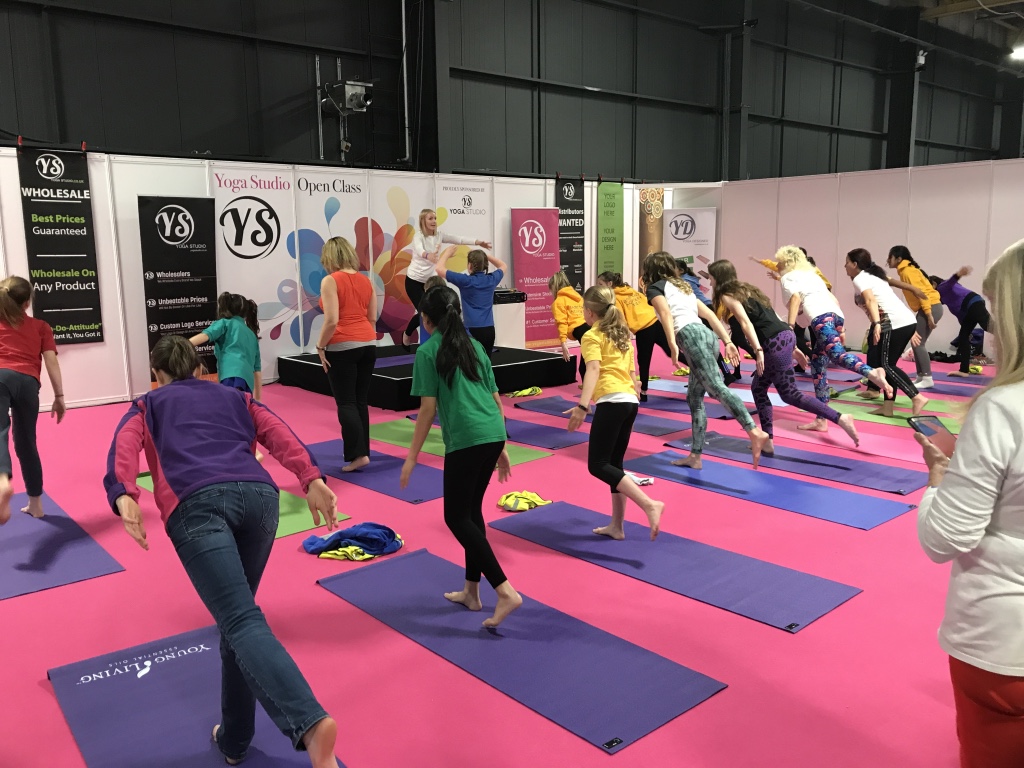
The hot yoga pod was absent this year, but had been replaced by an aerial yoga workshop space. I like that the Om Yoga show encourages attendees to get stuck into new incarnations of yoga as well as sticking to the traditional. Whatever your viewpoint on yoga, there will be something for you to enjoy here.

No review would be complete without a mention of the vegan food court – AMAZING! This year was the best selection of food I’ve ever seen at the show. So many local home kitchens and creative vegan cooks. It was hard to choose, but a special mention needs to go to Home Kitchen Vegan who produced the most fantastic vegan curry.
Special mention to my favourite exhibitors this year:
Yoga clothing to die for The Power of Greyskull
Yoga bliss from a world class teacher Yogi Ashokananda
I dare you to leave without trying one of these drinks by Big Juice
The Om Yoga Show will be back in London 20 – 22nd October 2017


